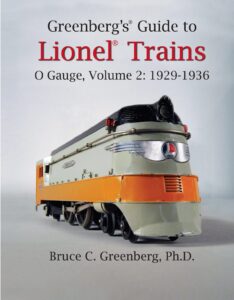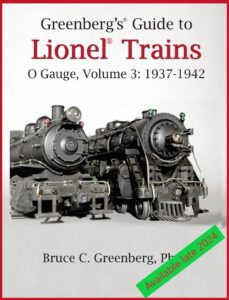Book Review: GREENBERG’S GUIDE TO LIONEL TRAINS: O GAUGE, VOLUME 2: 1929–1936
Author: Bruce C. Greenberg. 2021: Brinkmann Publishing LLC, Alexandria VA. Hardbound; 420 pages; $100. Available from http://Brinkmannpub.com
Reviewed by Dr. Joseph Lechner, TCA #01-52673 Spring, 2022
Dr. Bruce Greenberg is no stranger to the train collecting community. His published contributions over the past four decades have included reprints of Lionel catalogs, operating instructions and repair manuals; detailed study guides to IVES, LGB and Lionel trains; and pocket price guides, which are now updated annually by Kalmbach Publishing.
Greenberg’s Guide to Lionel Trains: O Gauge, Volume 2: 1929-1936 is the latest installment in an ambitious undertaking to expand and update the author’s previous guide to prewar Lionel O Gauge, which was first published in 1988. This volume and its companion Greenberg’s Guide to Lionel Trains: O Gauge Volume 1: 1915–1928 offer a new and greatly expanded understanding of Lionel production by using the locomotive outfits as the organizing principle. For the first time, the reader can understand Lionel production by combining the locomotive and its motor with its rolling stock and its packaging. These volumes therefore include detailed lists of cataloged Lionel sets as well as promotional outfits.
The years 1929-1936 were momentous ones for The Lionel Corporation, encompassing the Great Depression, Lionel’s bankruptcy and receivership, and its acquisition of IVES. Real railroads also experienced economic hard times, and they sought to win back the traveling public with streamlining, internal combustion, and other refinements. Lionel’s toy trains reflected those developments.
Some Lionel milestones that occurred during this era included:
- 1930: Lionel’s first O gauge steam locomotives.
- 1930: First die-cast locomotive frames in O gauge.
- 1930: First die-cast locomotive details (pilots, smokebox fronts, steam chests).
- 1930: budget-priced outfits with transformer included
- 1932: 027 track
- 1933: First locomotive sound effect (chugger)
- 1933: First six-wheel trucks in O gauge
- 1933: First drum reverse unit in O gauge
- 1934: First articulated train
- 1934: First “scale” model (752E City of Portland)
- 1934: 072 track
- 1935: Remote control whistle
- 1935: First die-cast locomotive body (250E Hiawatha)
- 1936: First injection-molded plastic part (locomotive classification lanterns)
- Gradual transition from brightly-colored toylike finish to more realistic appearance
- Transition from generic designs to representations of specific prototypes
STEAM COMES TO O GAUGE
Joshua L. Cowen started his Lionel Manufacturing Company in a loft in lower Manhattan. As the business grew through the 1900s and 1910s, both Lionel and its customer base were surrounded by a dense network of electrified railroads. Boys growing up in the New York metropolitan area would have been familiar with S-class electrics on the New York Central, boxcabs (box cabs) on the New Haven, and high-wheeling DD1s that guided Pennsylvania Railroad’s trains through the Hudson River tunnels to Manhattan Transfer. Little wonder that American Flyer, IVES and Lionel all offered toy locomotives based on these prototypes.
But outside the New York metro area, steam was king. Throughout middle America, hundreds of thousands of young boys flocked to the local depot to greet the arrival of a puffing, snorting iron horse. Toy train makers recognized this and offered youngsters toys that resembled the great steam locos that thundered through their towns. Lionel had made steam-outline models in “the rich boy’s gauge” (2-1/8”), but not in its smaller and more-affordable O gauge line (Greenberg notes that O gauge steamers were pictured in the firm’s 1915 and 1921 catalogs, but were not produced).
To be sure, electric-outline locos were less costly to manufacture. The flat surfaces of electrics were easier to duplicate with sheet metal. Steam locos had complex curved boilers, adorned with a myriad of appendages such as smokestacks, sand domes, steam domes, piping, whistle, and more. Their running gear included main rods, side rods, eccentric rods and valve gear linkage. Most steam engines pulled a tender—an additional cost item.
And yet, hundreds of thousands of potential customers dwelt in communities that were served by steam railroads. To reach these buyers, in 1930 Lionel added three steamers to its O gauge line.
#257 and #258 were stubby 2-4-0 types that measured 14½” long including their four-wheel tender. Similar in outward appearance, #257 ran forward-only, while #258 included a manual reversing switch for $1.50 more.
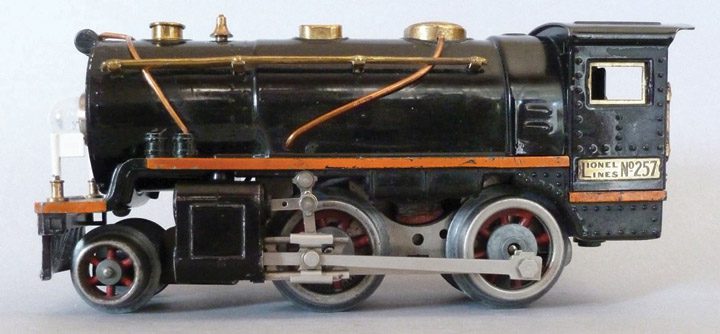
The much better-proportioned #260E came with a distant-controlled pendulum reversing unit and an eight-wheel Vanderbilt tender. Its 2-4-2 wheel arrangement would become standard fare in Lionel’s entry-level sets throughout the prewar and postwar eras. Copies of the postwar “Scout” loco are still being manufactured today. There were prototype 2-4-2 steam engines. One was exhibited at the 1893 World’s Columbian Exposition, and it is said to have been responsible for giving the Columbia name to this wheel arrangement. However, I have long suspected that Lionel’s 2-4-2s were based on the USRA ( United States Railroad Administration) Mikado (2-8-2), which was ubiquitous on American railroads from the 1920s through 1940s. One might think that 27” diameter curves dictated elimination of two driving axles, but the decision might have been an economic one.
Toy steam locos did cost more. Lionel’s cheapest electric-outline set in 1930 came with the #248 boxcab and two freight cars for $7. The cheapest steam outfit consisted of #257 with tender and two freight cars for $11.25. Despite their higher cost, steam trains must have sold well, because Lionel continued to produce a plethora of them throughout the prewar (and postwar) eras.
Greenberg devotes nearly half of this book (203 pages) to steam locomotives and the outfits which they pulled. Only a few electric-outline engines are described—small lithographed models which Lionel marketed as Winner, IVES and Lionel-Ives between 1930 and 1933. After a cursory inspection of this volume, one might get the impression that Lionel tried to distance itself from electrics by relegating them to budget labels. This could not be farther from the truth. Eight electrics that Lionel introduced in the 1920s continued to be available in the 1930s. Greenberg covered them in detail in his Guide to Lionel Trains; O Gauge, Volume 1: 1915-1928. He does not repeat that information here. Volume 2 covers trains that were introduced between 1929 and 1936.
027 TRACK AND LOW-COST STARTER OUTFITS
With few exceptions, early O gauge sets came without a transformer, which had to be purchased separately. One reason for this policy may have been that residential utility service was anything but standard in the teens and 1920s. Parts of New York City were still powered by direct current. A transformer cannot work on DC. Some daring operators regulated train speed by manipulating light bulbs connected in series. Municipalities with alternating current had different frequencies that ranged from 25 Hz to 60 Hz. Each dealer would have stocked transformers which were suitable for that locality. Many households in rural America did not yet have electric service. Fortunately for them, toy trains had universal motors, which could operate on battery power.
In 1930, Lionel introduced low-cost outfits that included a transformer. At first, they came with the same OC and OS sections as did higher-priced trains. Beginning in 1932, these sets came with the less-sturdy (and cheaper to manufacture) 1013 curved sections and 1018 straight sections that we have come to know as 027 track. Outfits were branded Winner in 1930; IVES Corporation in 1931-32; LIONEL-IVES in 1933; Lionel Jr. in 1934; and ultimately 027 in 1937.
It would be easy to assume that these budget-priced trains were Lionel’s response to the economic depression that gripped the United States following the stock market crash of October 1929. To the contrary, Greenberg argues that the Winner line was intended to counter competition from American Flyer and IVES, and that Lionel must have begun planning it in 1928–as much as a full year before Black Tuesday (he further asserts that large numbers of families were not adversely affected by these events until 1931).
Greenberg illustrates his thesis by pointing out that, in 1927, Lionel’s cheapest outfit (#292) consisted of a four-wheel boxcab electric and two 4-wheel coaches for $6.75. Comparable outfits from American Flyer (Suburban) and IVES (Green Mountain Express) were priced at $5.50. (None of these sets included a transformer). Lionel’s introductory Winner outfit (1930) sold for $5.95 with transformer. Winner trains were made of lithographed sheet metal (which Lionel had previously denigrated as cheap and flimsy), but they were less expensive to manufacture than Lionel’s enameled-steel trains with window inserts and nameplates.
At any rate, in its 1930 catalog Lionel established a pattern that would persist throughout the postwar and Fundimensions eras: 027 outfits included a transformer, while the more expensive O (and Super O) sets did not. In the twenty-first century, 027 has given way to Fastrack; transformers have been replaced by wall warts and remotes; but the nine-decades-old distinction continues: introductory-level trains are packaged with track and power supply, while deluxe outfits come with neither.
THE TREND TO REALISM
Toy trains of the mid-1920s were painted in a kaleidoscope of bright colors and trimmed with nameplates and other details in gleaming copper, brass or nickel. Joshua Lionel Cowen famously remarked that most of his trains were purchased for boys by female relatives, and “women buy on color”. Nevertheless, during the 1930s, Lionel gradually changed its decoration methods to represent more closely what was seen on full-sized railroads.
Consider first the 262E steam loco as it was manufactured in 1933. Boiler and cab were painted glossy black. Steam locomotives may have looked that way when they emerged from the erecting bay, but they did not stay shiny for long. Wheel spokes were painted bright red, a feature that was common on European engines of that era, but not often seen in North America. Most trim pieces were made of copper. On a real locomotive this metal would have oxidized to a green patina. Why was there a sand pipe coming down from the steam dome?
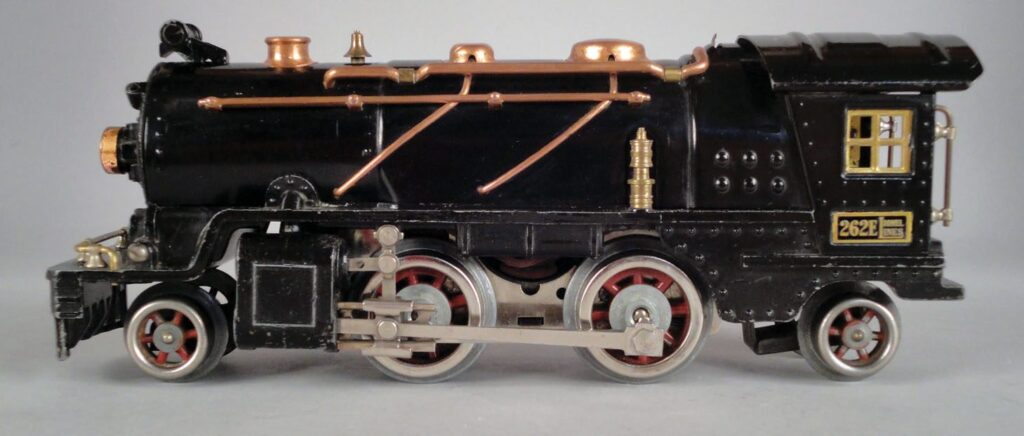
Now compare with the 1935 version of the same locomotive. The body now had a satin black finish that better captured the look of a hard-working steam loco. Wheel spokes were painted black. The pony wheels were solid rather than spoked. Trim pieces were nickel rather than copper. Both sand pipes were connected to the sand dome, as they should be.
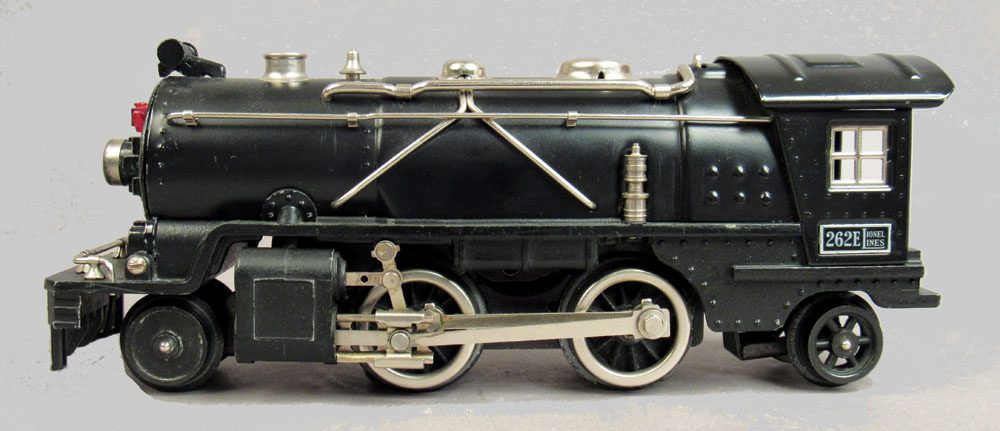
Beginning in 1935, steam locos came with marker lanterns that were molded of a transparent red plastic. These piped some light from the headlight bulb inside the smokebox. As far as I am aware, this was Lionel’s first use of injection molding to manufacture a visible detail part. Remarkably, the same piece (this time in colorless plastic) would be used on postwar NW2 switchers, beginning with 622 and 6220 in 1949.
Next, consider the 813 cattle car, which from 1927-1930 came in a garish orange / green combination. Shiny brass plates proclaimed the LIONEL name and catalog number. Journal box covers were bright nickel. Latch couplers were shiny and looked nothing like the knuckle couplers on real railroads.
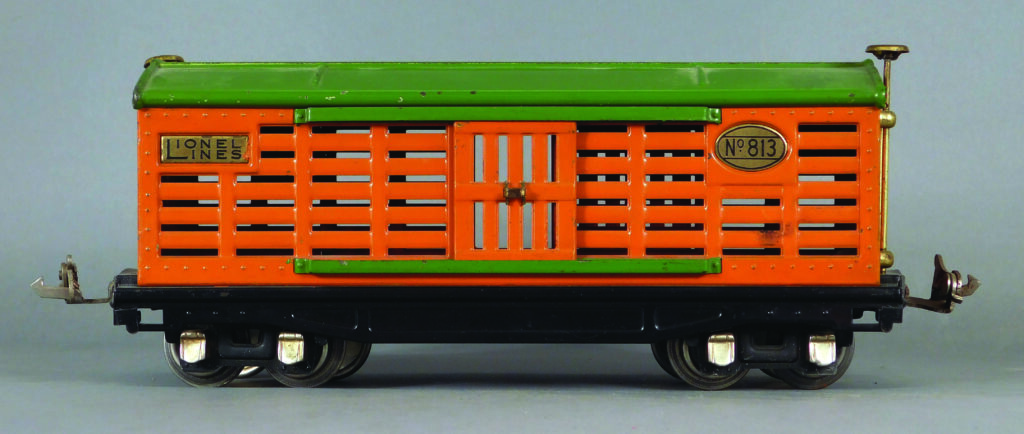
In 1940, the 813 was painted a realistic Tuscan red with white rubber-stamped lettering. Journal covers were blackened. The box couplers, while still oversized, approximated the appearance of knuckle couplers.
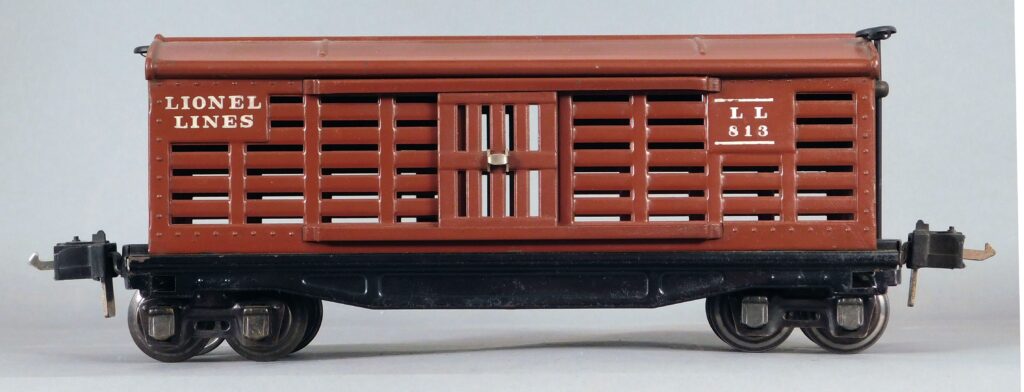
REPRESENTING A PROTOTYPE
Toy steam locomotives like 260, 262 and 249 had a generic appearance. They did not represent a specific full-sized engine; and, of course, tenders were lettered LIONEL LINES rather than the name of an actual railroad. For that matter, real steam locos of the 1920s were generic-looking too, since most railroads used copies of standard USRA designs. That began to change in the mid-1930s, as railroads developed streamlined trains and hired industrial designers to create distinctive looks for them. Lionel’s O gauge offerings reflected these exciting changes. When we look at a #238E (introduced 1936), it is obviously intended to represent PRR #3768, a K4s Pacific for which Raymond Loewy designed a streamlined shroud. Never mind that Lionel’s “Torpedo” lacks one pair of drivers; the resemblance is unmistakable.
Likewise, #264E and #265E (1935) clearly captured the upside-down-bathtub look of NYC #5344, despite the model’s 2-4-2 wheel arrangement which fell short of the real Commodore Vanderbilt’s 4-6-4 configuration.
SCALE MODELS
Union Pacific made headlines when it unveiled its M-10,000 in February 1934. Its internal-combustion prime mover and electric traction motors were not new, but their application to a high-speed passenger train was. Constructed of aircraft-grade aluminum, the entire three-car train weighed little more than a single “heavyweight” Pullman. M-10,000’s power car carried enough distillate fuel to propel it 1200 miles, in an era when steam locomotives stopped for water every 100 miles or less. Union Pacific’s streamliners would revolutionize railroading in another way. Prior to 1934, the typical passenger train consisted of a black steam locomotive pulling olive-green cars. One company’s equipment looked pretty much like every other’s. Beginning with M-10,000, railroads adopted distinctive, eye-catching liveries. Nine decades later, Union Pacific diesels still wear the Armour yellow that debuted on its City of Salina.

Lionel’s model of M-10,000 was as groundbreaking as its prototype. For starters, it was an accurately-scaled model of a specific prototype. Page 13 of the 1934 consumer catalog proclaimed it “by every measurement, 1/45 actual size of that streamlined beauty of the Union Pacific Railroad”. The 1/45 scale ratio was preferred by many serious hobbyists of the 1930s, since it yielded trains that were correctly proportioned to O gauge (1.25”) track. But Lionel’s articulated three-unit consist wasn’t quite 1/45 the length of the real train. Greenberg quotes Ken Morgan, who pointed out that the real M-10,000 measured 204’ long. A true 1/45 scale model should have been 54.4 inches long; Lionel’s version was only 46-3/8”. Lionel wasn’t alone in resorting to selective compression. Even the most sophisticated scale model railroaders (in both O and HO) built 60’ “shorty” passenger cars instead of the prototypical 80’, as a quick glance through a vintage Walthers catalog will confirm.
The 752E was groundbreaking in several other ways. It was the first Lionel train since 1927 to be lettered with the name of an actual railroad. It came with an oval of brand-new 072 track, which is still prized by 21st-century hobbyists for its realistic operation. It was one of the first outfits to come with the now-familiar orange-and-blue tube of Lionel lubricant (previously, Lionel supplied samples of 3-in-1 oil in its train sets).
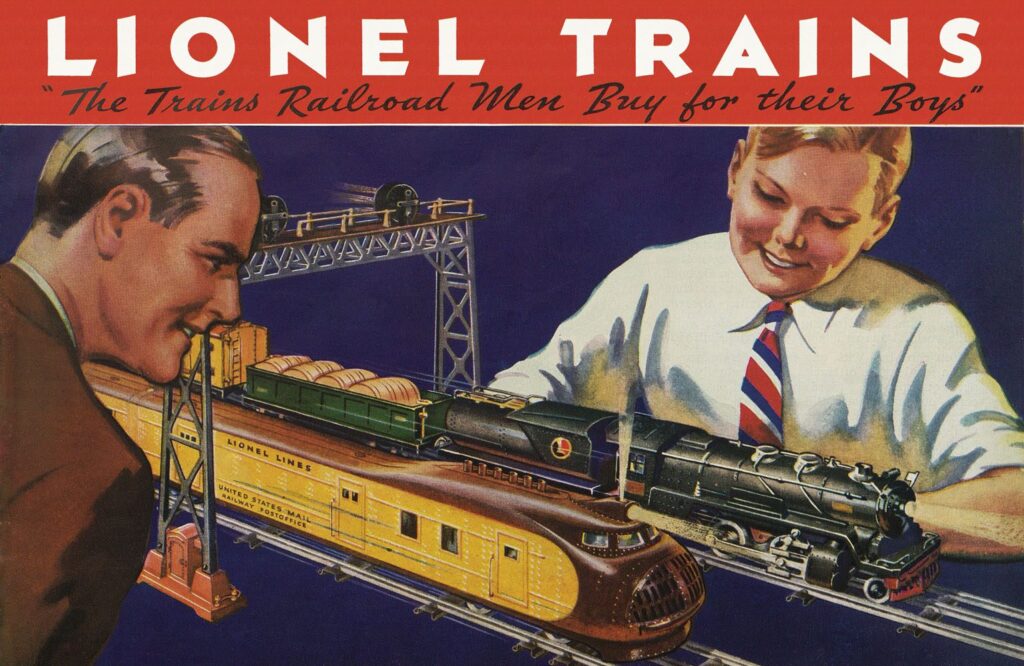
752E was prominently featured on the cover of Lionel’s 1934 consumer wishbook. I have displayed a lithographed facsimile of that artwork for decades without realizing its historical significance: according to Greenberg, this was the first time O gauge trains appeared on the cover of a Lionel catalog.
Lionel’s biggest news for 1935 was a replica of Milwaukee Road’s streamlined Hiawatha. Its cars were redecorated versions of M-10,000’s articulated coaches and observation (the real Hiawatha cars were not articulated). However, the 250E locomotive was an accurate model of The Milwaukee Road’s A-class Atlantic. It was Lionel’s first use of a one-piece die-cast body shell. 250E was also the first Lionel O gauge steamer to feature the correct prototypical wheel arrangement!

“Scale” model railroaders of the 1930s and 1940s bought Lionel M-10,000s and Hiawathas and adapted them for outside-third-rail operation.
SUMMING UP; LOOKING AHEAD
During the eight-year period covered by this volume, Lionel O gauge trains evolved from brightly-colored playthings to accurately-scaled representations of recognizable prototypes. Lionel’s quest for greater realism was supported by new manufacturing technologies, such as Zamac die-casting and molded plastics. These trends would converge to set the stage for what many regard as Lionel’s all-time greatest achievement: the 700E scale Hudson. Greenberg’s Guide to Lionel Trains: O Gauge, Volume 3: 1937-1942 (due in 2024) will cover these scale trains and other Lionel products of the late prewar era.
A TEAM EFFORT
In a recent issue of Model Railroader, contributing editor Tony Koester contrasted two approaches to the hobby. There are “lone wolves” who enjoy trains in the privacy of their basements. Then there are hobbyists who join clubs, host operating sessions, and participate in online forums. Both approaches are OK—it’s your leisure time to spend as you choose—but a work like Greenberg’s Guide to Lionel Trains: O Gauge, Volume 2 is a community effort. Such a detailed analysis of the history of toy train production requires careful inspection of multiple specimens whose provenance can be documented. Greenberg acknowledges the contributions of more than 100 collaborators. In particular, he credits Dave McEntarfer for listing the contents of more than 250 outfits.
IN CONCLUSION
If you seek to understand Lionel’s production from this very creative period, you need this volume. If you favor the richly-detailed trains of the postwar era, this work helps explain how they came to be. Greenberg’s new book is encyclopedic in scope and a remarkable addition to the study of toy trains.

